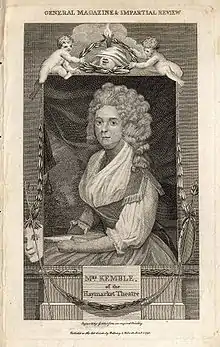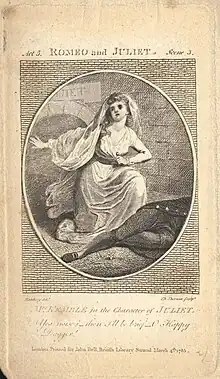
Elizabeth Kemble (née Satchell; 1763 – 20 January 1841) was an English actress.
Life
Elizabeth Satchell was born in London, and she was a talented performer when she married Stephen Kemble, of the Kemble family, in 1783. They acted together for several years both in London and in the provincial circuits. She also wrote a pastoral, Philander and Rose; or, the Bridal Day, which was produced in Manchester on 25 April 1785).[1]
Satchell outlived her husband by 19 years. Her most famous role was Yarico from the opera Inkle and Yarico, for which she was considered "universally" to be the best "ever seen".[2] She died near Durham.
Reputation
Theatre manager Tate Wilkinson declared that next to Susannah Maria Cibber, Elizabeth Satchell was the best Ophelia he ever saw.[3]
The editor of Blackwood's Magazine reported:
"In all the parts she played she was impassioned; and all good judges who remember her will agree with us in thinking that she was an actress, not only of talent but of genius."
James Boaden was enthusiastic in her praise.[4] In 1792, the Thespian Magazine reported that "[Satchell] summons the resistless tear of compassion into the eyes of the most rugged and insensible – and while sympathy and feeling shall hold a place in the human heart, her representation of Yarrico [sic] will be attended with delight, and remembered with the most unbounded admiration.”[5]

References
- ↑ Mann, David (1996). Women Playwrights in England, Ireland, and Scotland, 1660-1823. Bloomington: Indiana University Press. p. 391. ISBN 0-253-33087-4.
- ↑ Oxberry's Dramatic biography and histrionic anecdotes, Volume 2 by William Oxberry, Catherine Oxberry, pg. 280
- ↑ "Some aspects of provincial drama in the eighteenth century", Frederick T. Wood English Studies, Volume 14, Issue 1 - 6 1932 (pg. 73)
- ↑ Blackwood's Magazine, 1832, pp. 214-15, vol. i. also see "Life of Siddons."
- ↑ Thespian Magazine, 1792, p. 94.
Links
- Dictionary of National Biography
- Encyclopædia Britannica